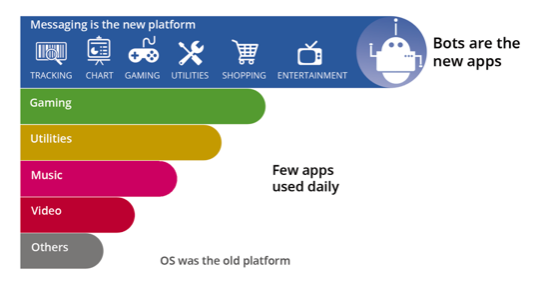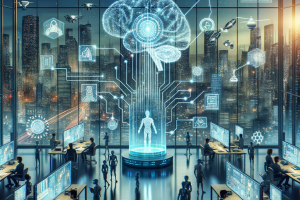FROM PROF. DR. PETER GENTSCH
Imitation of human entertainment In the beginning, bots could respond to simple, repetitive requests that followed simple rules, such as “What’s the weather like today? With advances in artificial intelligence and machine learning, more sophisticated tasks can now be performed by bots. The idea of bots dates back to the 1950s when Alan Turing, an early researcher in computer intelligence, presented an experiment to test the intelligence of machines. This is now known as the Turing test and works like this: If more than 30% of an experimental group is convinced that they are having a conversation with a human and not with a computer, the machine is assumed to have an intelligence equal to that of a human.
In 2014, a small breakthrough was achieved when a third of the participants were convinced that they had had a conversation with a human being, even though a bot was used. Nowadays it is not always easy to tell the difference between a human and a machine in a conversation. Even comparatively little artificial intelligence is enough to imitate the illusion of natural human interaction. However, the developers of bots still face many challenges in this respect. Their goal is to develop a common language between machine and human to facilitate communication.
Interfaces for companies To enable companies to offer their services on messaging platforms, there must be programming interfaces (API). The APIs allow external program code, such as a bot, to be integrated into existing software, for example a messaging platform. Not all companies have the expertise to build their own bot and integrate it into a messaging platform. It is therefore likely that in the future there will be more bots-as-a-service concepts that simplify the development and integration of bots.
Bots as a new operating system Bot development will lead to fundamentally different principles in communication and the corresponding interfaces. Bots will replace the majority of websites and apps. They remove the separation of application-related functions. For example, a transaction may involve the evaluation of a product, selection, purchase and service. Typically, a consumer would have to use different apps and/or websites for this. As a kind of operating system, the bot combines the various forms of information and interaction to form an integrated transaction.

Figure: Bots as new operating system
The bot has made a selection according to the learned preferences, triggered the order and completed the transaction using the bank and address data known to him. Of course, corresponding permission states can be used here, which are controlled by the respective consumer.
Bots and artificial intelligence – how intelligent are bots really? Chat bots are currently heavily loaded with the performance attribute AI. However, most bots are currently still implemented in a relatively trivial way. As a rule, Twitter and Facebook feeds are scanned for certain keywords, on the basis of which predefined texts or text modules are then automatically controlled. Somewhat more intelligent are systems that automatically detect relevant text findings from the Internet and then combine them into a post. This automated form of content curation is also discussed under the term Robotm Journalism. In order to enable chat bots to capture the posts accordingly, the now significantly advanced methods of Natural Language Processing (NLP) are used, which transform the continuous text into corresponding semantics and signal words.
Another approach is to connect the chat bots with knowledge databases. For the user, the chat bots appear “intelligent” due to their information competence. However, the chat bots are only as intelligent as the underlying database. Due to the progress in AI (increasing amounts of data available for training and deep learning approaches), chat bots can be made more intelligent in the future. AI-based chat bots learn largely independently from the huge amounts of available online data and recognize question-answer patterns, which they use automatically in customer communication. However, the example of Microsoft Tay mentioned above shows that the uncontrolled training of bots by the community can have fatal consequences. The next generation of AI-based bots must control and design the possible communication space accordingly.
Thus the degree of information supply is directly related to the degree of intelligence and automation of the bots. The current (usually not intelligent) chat bots are fed by the keywords, knowledge modules, texts and rules of their developers/programmers. The more intelligent form of bots also obtains information independently from online sources and combines it into new content. The AI-based bots are also fed by the answers and reactions of the users. This also reduces the possibility of controlling the information used for learning. In addition to content, social signals such as likes and followers are also important feed. These strengthen or reduce the impact of chat bots. This feedback information can also come from other bots.
So-called bot armies can thus spread content and opinions virally in a short time and thus automatically set topics and agendas. Initially, bots could respond to simple, repetitive requests that followed simple rules, such as “What’s the weather like today? With advances in artificial intelligence and machine learning, more sophisticated tasks can now be performed by bots. The idea of bots dates back to the 1950s, when Alan Turing, an early researcher in computer intelligence, presented an experiment to test the intelligence of machines. This is now known as the Turing test and works like this: If more than 30% of an experimental group is convinced that they are having a conversation with a human and not with a computer, the machine is assumed to have an intelligence equal to that of a human. Eugene Goostman, a chatbot developed since 2001, is said to have succeeded in doing this for the first time.
The bot imitates the personality of a 13-year-old Ukrainian boy. In a competition in 2014, which was organized on the occasion of the 60th anniversary of Alan Turing’s death, Eugene Goostman succeeded in convincing 33% of his human chat partners that he is a human and not an AI system. It was then declared that the bot had passed the Turing test. However, this conclusion was controversially discussed, as it was considered a trick to choose the character of a 13-year-old Ukrainian boy, who could quite easily hide knowledge gaps and structural inadequacies. Nowadays, it is not always easy to make out the difference between humans and machines in a conversation. Even comparatively little artificial intelligence is enough to imitate the illusion of natural human interaction. However, bots developers still face many challenges in this respect. Their goal is to develop a common language between machine and human to facilitate communication.
Up to now, bots have usually been programmed in a rather trivial, one could even say “stupid” way. In the age of artificial intelligence, this will change permanently. Earlier implementations used internal databases, text modules tagged by keywords and rules of the developers. The bot scans the customer input for keywords, then assembles the knowledge and text modules according to the firmly implemented rules and returns the output thus generated to the customer. Extensions of the system in the form of new knowledge, rule links, keyword tagging and text modules must be programmed. Questions that the systems do not understand or to which they have no answers in their corpus are answered with counter-questions and evasive manoeuvres. Today’s bots also use the largest available dynamic database in the world: the Internet. The Semantic Web, i.e. the collective effort of content uploaders in hypertext to tag information semantically and in a standardized way and thus make it machine-readable, facilitates automated access to knowledge. Using the customer’s interaction patterns, the bot can use the deep learning algorithms of machine learning to find customer-specific keywords and automatically maintain its own database on a customer-specific basis. Intervention by the developer is only necessary for maintenance purposes.
Recent breakthroughs in Natural Language Processing (NLP), the part of AI that deals with human-machine communication, are making bot development even more dynamic. As early as 2014, it has been possible to develop chat bots that simulate a human language partner for over a third of human users. In the meantime, it is possible to put more than 90% of the spoken word into a context of meaning, even in oral communication. However, written communication in this field is much more developed and therefore more widespread. Thus, the degree of information supply is directly related to the intelligence and automation level of the bots. The current (usually not intelligent) chat bots are fed by the keywords, knowledge modules, texts and rules of their developers/programmers. The more intelligent form of bots also obtains information independently from online sources and combines it into new content.
The AI-based bots are also fed by the answers and reactions of the users. This also reduces the possibility of controlling the information used for learning. Bob and Alice, two AI-based chat bots in Facebook’s research lab for artificial intelligence, FAIR, invent a language that their human inventors do not understand. The original idea was to teach the chat bots to negotiate. In doing so, the systems developed their own language among themselves, which even creators could not understand. It sounded something like this: Bob: I can can I I everything else Alice: Balls have 0 to me to me to me to me to me to me to me to This independence and the apparent loss of control were discussed in the press almost panicky up to apocalyptic end-time scenarios. Some saw the development to Skynet developed, others saw in the sense of super intelligence or singularity the decline of our civilization. But it is by far not that dramatic yet. Bob and Alice were supposed to negotiate about different virtual items, with each bot giving priority to certain items over others.
The AI should now find out in the dialogue where the preference of the other bot lies. Which in principle also worked well, if the developers had not forgotten to reward the bots for following the modalities and rules of the English language. And so Alice and Bot started to use a kind of computerized shorthand. Facebook then reset the bots to adjust the reward system accordingly. Much more exciting, but not reported in public, is that the systems learned to behave tactically and also to lie if necessary in order to get what they want. Alice and Bob behaved as if they were apparently interested in certain things, only to leave them for the other bot to do. Even though the bots were not taught how to do this, Alice and Bob were able to haggle for the item they wanted.
Facebook’s chief AI developer Dhruv Batra put the scare tactics and alleged loss of control into perspective: “Changing the parameters of an experiment is not the same as pulling the plug on an AI. If that were the case, every researcher would do it all the time when a machine is supposed to do another task.” In order to be able to use such a bot system in a more targeted manner in the future, the FAIR researchers have reinstalled the system with the aim of enabling Alice and Bob to successfully negotiate with humans in the future.
MITSUKU AS BEST PRACTICE KI-BASED BOT
The Mitsuku bot, which runs on Pandorabots, one of the most powerful conversational artificial intelligence chatbot platforms, won the Loebner Prize in 2013, 2016 and 2017 for the worldwide human-like chatbot. Mitsuku’s answers are extremely fast and catchy, so you get the impression of talking to a real person for a while. The following picture…

…makes it clear that the quality of AI-based bots is strongly related to Big Data. Since people all over the world talk to Mitsuku, a global training set is created, which enables AI to learn and become permanently better. Even though Mitsuku was not developed for any specific company purpose, it shows well the quality that future bots based on Big Data and AI will achieve.
POSSIBLE LIMITATIONS OF KI-BASED BOTS
The examples above already show the current potential of AI-based bots. At present, these systems are still in an early stage and still have certain limitations and optimization potential. AI-based chat bots learn largely independently from the huge amounts of available online data and recognize question-answer patterns, which they use automatically in customer communication. However, if they are trained incorrectly, fatal results can be achieved.
TWITTER BOT TAY FROM MICROSOFT
Most bots are currently reactive service bots. Going one step further are engagement bots that actively interact with users as market and brand ambassadors. The best-known example here is Microsoft’s Chatbot Tay. Unfortunately, the community has trained him negatively, so that he posted right-wing extremist and sexist contributions. Within a day, the bot learned a lot from his conversation partners on Twitter and developed from youthful chumminess to a “hate bot … that sent out anti-feminist, racist and inflammatory tweets”. Such a loss of control over a bot would have serious consequences for a company’s customer service. Within a day, Microsoft apologetically removed Tay from the net. The example shows that the uncontrolled training of bots by the community can have fatal consequences.
AI systems have yet to learn ethical standards. So it turns out that bots also need a kind of guideline. Just as a journalist follows editorial guidelines, bots must adhere to certain standards. The next generation of AI-based bots must control and design the possible communication space accordingly. IBM Watson has already achieved some respectable successes in the AI field, such as winning the much-cited Jeopardy game Champs Of The Champions (all winners of the Jeopardy quiz game competed against each other). To make the system look even more human, IBM researchers have tried to add the Urban Directory as a training record. The Urban Directory includes colloquial language and slang. The limitations of the current AI are that the system cannot really distinguish between obscenity and politeness. So Watson answered a serious question from a scientist with the word “bullshit”, which was certainly not adequate in this context. Humans can do this interpretation and reasoning intuitively – AI systems currently do not.
BOTS – CHANCE OR RISK FOR COMPANIES, CONSUMERS AND SOCIETY?
The importance of chat bots will increase in two ways. On the one hand, chatbots will make communication more efficient in a positive sense. Fast answers or personalized filtering of information will increase user usability and convenience in social networks. Unfortunately, “the dark side of bots” will also gain in importance. It is easy to create positive buzz for your own product and negative buzz for your competitors. This is made easier by the fact that everyone on the web can be not only a reader but also an author. Since for many readers, information from digital sources contains a great deal of opinion and decision-making power, the temptation is great to intersperse disinformation as an author.
The use of chat bots for targeted promotion, disinformation and manipulation does indeed carry a high risk for companies. However, the subject matter is not new. In the past, many companies have commissioned agencies to remove or cover up negative posts in social networks, to push topics or give positive ratings or negative ratings for the competitor. Some companies did not survive exposure and suffered image damage or had to endure bad shit storms. We have also been dealing with the phenomenon of astroturfing for a long time. Now this process can be automated and scaled. It can be performed so smartly that the probability of being discovered is relatively low. Many brands and organizations will not be able to resist this temptation. Professionally made disinformation and manipulation by bots is indeed difficult to detect at present. Therefore, systematic prevention is also difficult.
On the other hand, there are also glimmers of hope. On the one hand, the community hygiene of social networks should not be underestimated. Just think of the Gutten-Plag Wiki. Attentive and sensitive users recognize and report these manipulative currents if necessary. On the other hand, it is to be hoped for an increasing sensitization of journalists, users and companies, who accordingly awake and critical evaluate and channel information in social networks. A systematic, data-driven approach automatically detects patterns of manipulative bots, for example posting frequency and times, follower network, content and tonality. AI methods are used for detection and prevention. These methods have also been successfully used for click and credit card fraud (Fraud Detection). In a sense, we beat the manipulative bots with the same weapons they use for automated disinformation and manipulation.
CUSTOMERS ARE ALSO UPGRADING – BOTS AS BUTLERS AND INTELLIGENT ASSISTANTS
However, intelligent bot systems are not only used by companies, but also increasingly by consumers. On the consumer side, Amazon Alexa or Google Home, for example, are digital assistants that help to simplify the search for information or the ordering of products.
THE BUTLER ECONOMY – CONVENIENCE BEATS BRANDING
Traditionally, we understand a butler as a personal servant who is always available and fulfils our wishes. A conscientious butler knows us so well that he can even anticipate needs and make recommendations. With bots that are capable of learning and can therefore be called intelligent, the step to the personal butler, the digital personal assistant, is not far away. The major tech companies Amazon and Google have been offering digital servants for the home since 2016: Echo and Home are stand-alone devices that resemble speakers and take over the regulation of light, temperature and music, as well as weather requests, alarm clock functions and requests for information.
Google Home can also send email and text messages, as well as sort photos and use mapping services. What all virtual assistants have in common is that they’re supposed to perform everyday tasks, such as booking hotels or taxis, ordering clothes, food or flowers, or even banking or creating to-do lists. Instead of spending hours comparing quotes, entering account information or finding the right app for notes, these often tedious necessities can then be completed in the time it takes to say a sentence.
And when people are no longer needed for these activities, human resources could be used in other ways, for example for creative tasks. In the following section we will first explain why the convenience of the personal butler will reduce the importance of the brand. Then the past and future development process of the digital butler is described and it is discussed whether in the long run oral or written communication with the assistant will prevail. At the end of the section, the advantages and disadvantages that may arise for consumers are highlighted.
CONVENIENCE BECOMES MORE IMPORTANT THAN BRAND
All major tech companies are currently fighting for the best personal assistant. The field is lucrative, as people with a personal assistant will spend even more time on their mobile phone and therefore both advertising revenue and device sales can increase. The search for keyword terms, for example via Google, is likely to disappear in the long term as part of this development. Instead, the purchase decision process will be conducted in conversation with the digital assistant. Product recommendations in social networks may also become less important. It is likely that products suggested by the personal assistant will be better tailored to the user than ever before, since the assistant has a greater amount of information available than that on which personalised advertising is based.
If the consumer is presented with more products that are more appropriately tailored to him or her, it is likely that more products will be consumed overall. For a brand or a company to be successful in the future, it is therefore important that the respective products and services are taken into account by the algorithm of the personal butler. If the user then wants to order flowers, book a hotel or buy a jacket, the personal assistant will only consider those companies that are present in the algorithm’s network. For Google’s personal assistants, on the other hand, the ranking of results in Google searches could play a major role. In the future, customers will focus less on the brand than on convenience. This means that companies that know how to be connected to the relevant personal assistants will win. Amazon, for example, could soon offer private labels via convenient ordering processes without having to give up margins. The first step in this direction is the Amazon Dash Button, which will be introduced in 2016. This is a button that is attached to appliances to enable users to order refillable goods, such as detergent or toilet paper, at the touch of a button.
BOTS UNDER THE CRM OF COMPANIES
If more and more bots are used in companies, CRM will also increasingly develop into “BRM – Bot Relationship Management”. With each customer contact, the bot learns more about the customer’s needs and preferences. It functions as a fully automated, smart customer advisor that can recognize and immediately fulfill the wishes of the client like a good friend. Fully personalized up- and cross-selling increases customer satisfaction and purchase frequency. With the help of these personal assistants, each company’s CRM system becomes fully autonomous, achieving unprecedented efficiency and the best possible customer proximity. The search for a suitable and inexpensive flight can be tedious. What if you can simply ask a bot for the cheapest flight? Lufthansa, for example, with its helpful avatar “Mildred” (mildred.lh.com) has directly recognized the signs of the times and released a best-price search bot at the end of 2016, initially as a beta version still learning.
In a friendly conversation with Mildred, you can inquire about the cheapest flights within the next 12 months in either German or English and book them directly. Admittedly, the language requirements are not particularly high, as the conversation should not take any surprising turns. Of course, you can narrow down the search period further and specify the booking class if desired, but the content of the conversation is largely the same, which doesn’t make Mildred any less useful. It is linked to various databases, including “Lufthansa Nearest Neighbour” for airport searches by city name or three-letter codes. Using the interface to “Google’s Geolocating”, Mildred is even able to assign sights to airports. An inquiry, for example about the Eiffel Tower, is translated into the flight destination Paris. Based on this data, Mildred queries the Lufthansa “Best Price” database to find the best price for the requested connection, which can then be booked via a link. The classic inbound touchpoint bot in customer service is provided by Freenet TV, a service provider for digital television.
It provides round-the-clock advice on reception and connection problems, among other things, and can thus provide initial assistance quickly. In contrast to Mildred, the customer does not write, but clicks on pre-programmed answer selections and is guided step by step through an initial problem diagnosis and solution. Video instructions are often posted, making the service quite useful as a first point of contact. However, since technical problems can quickly become very complex, the bot reaches its limits after a few questions and forwards to the classic customer service on request.
The bot of the Dutch airline KLM offers real customer service. The customer can change his seat, can check in via Facebook Messenger and receives constant information about his flight. So there is no rush when the plane is a few minutes late and the passenger may still be in the security check. Once activated, the bot proactively notifies the customer if the departure is delayed. The customer can address all questions to the bot around the clock – anything that the machine cannot answer or handle itself is routed to the service center and answered from there. Unlike most bot applications, the KLM bot has a connection to the service centre’s CRM and is therefore able to escalate service cases that the machine cannot handle.
SPOOKY BOTS – PERSONALIZED DIALOGUES WITH DEAD
In 2016, a really unusual development of a chat bot occurred: a reminder bot for a deceased friend. Eugene Kuyna, a Russian-born bot developer from Silicon Valley, came up with the idea after receiving the horrible news of Roman Mazurenko’s accident. Despite all her ethical concerns, she collected thousands of lines of chat from other relatives and used them to feed a neural network; in other words, she proceeded in a similar way to how Amazon developed Alexa or Apple Siri. The results are both fascinating and frightening. Many of Mazurenko’s friends who talked to the bot were amazed at Mazurenko’s unique expression, which his bot perfectly imitated in many places.
Even his humour often comes out. For example, a friend wrote to him: “You are a genius!” and the bot replied glibly, like Mazurenko himself: “And handsome!” Kuyna collected some log-files of the chats to get an idea of the result. She noticed that the bot listened more than it told. For many relatives, the benefit of the bot was very therapeutic. They were still able to tell him things they had always wanted to say. Many were able to say goodbye to him – even if only virtually – which would not have been possible without the digital avatar. But the effect can also be the opposite and the mourning phase of the relatives can be suppressed and prolonged.
This unusual and relevant example shows very closely the possibilities that are open to everyone in our modern times with this technology. The social weighing up of costs and benefits is at least as important as the continuous development of the technology. We live in an age in which everyone individually and society as a whole must think about the responsible use of new technologies in order to ensure that they are used in a meaningful and profitable way. As many advantages of AI as any technology brings with it, there are certain risks that must be identified and avoided.
BOTS – QUO VADIS?
The next generations of bots will certainly become truly intelligent in the sense of AI. This intelligence has two facets. On the one hand, in a positive sense, it can increase the user experience through high response and communication quality. Secondly, this intelligence can also be used manipulatively. This creates a kind of arms race: Who can use AI faster and better for his purposes? The bot developments of Cortana, Alexa, Google Home/Assistant, VIV etc. will further fuel and advance bot development. The focus is not on the much-discussed voice control as an interface, but on the increasing learning ability and intelligence of the systems. Another bot trend is the intelligent networking and reinforcement of distributed and interacting bots. Swarm bots, bot farms and bot networks will multiply the complementary and synergetic effects of bots. Bots will mutually reference each other and thus reinforce and share the desired discourse – in both a positive and negative sense.
BOTS – SALVATION BRINGER FOR COMPANIES OR CONSUMERS?
An important advantage of bots is that they are not only event-driven – they are in a continuous mode, so to speak. Consumers have gone online for a specific purpose or opened an app. The bot, which is now really “always on”, can permanently act in the consumer’s interest: Providing appropriate information, highlighting low priced product offers, alerting them to potential problems. A correspondingly smart bot could then also provide the right answers and carry out transactions. While the permanently rising Whatsapp, Facebook and LinkedIn messages increasingly shape our daily routine or even disturb it through their irresistibility, these smart, autonomous bots would give us more freedom again by filtering the flood of information and answering accordingly.
Bots like x.ai can already manage calendars and appointment-related e-mails with high quality. Internet, Big Data and AI have contributed to the increased complexity. This technology, implemented in bots, also helps to better deal with the increased complexity of information and channels. The exciting question will be to what extent the information and decision-making autonomy of consumers will increase through bots and assistants. In terms of consumer sovereignty, the bot of a consumer, as the digital representative of his interests, should not be part of a proprietary ecosystem alone, which lulls the consumer into its respective filter bubble. Rather, it must be a bot of its own that interacts confidently with other companies – or their bots. In the future, we will thus have to deal not only with bot-to-bot communication, but especially with a C-bot-to-bot communication.
On the other hand, company bots will increasingly proactively look for the relevant micro moments of consumers in addition to the currently dominant service function: I want to buy, I want to know, I want to go, I want to do… These can then be automatically satisfied by corresponding offers. Of course, these moments can also be triggered by the respective consumer bots and not by the consumer personally. In the final analysis, this would mean that tomorrow’s marketplaces would only be populated by bots that have been fed accordingly by consumers and companies. Surely this may seem somewhat futuristic. However, if you look at today’s real-time bidding and financial trading systems, this scenario does not seem so far off. At least not as far as the fantasy-filled science fiction scenarios in which AI takes over the rule of mankind.



